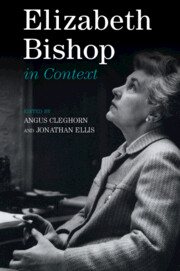Book contents
- Elizabeth Bishop in Context
- Elizabeth Bishop in Context
- Copyright page
- Contents
- Figure
- Contributors
- Acknowledgements
- Note on Referencing and Abbreviations
- Chronology
- Introduction
- Part I Places
- Part II Forms
- Part III Literary Contexts
- Part IV Politics, Society and Culture
- Chapter 18 War
- Chapter 19 The Cold War
- Chapter 20 Music
- Chapter 21 Psychoanalysis
- Chapter 22 Religion
- Chapter 23 Anthropology
- Chapter 24 Travel
- Part V Identity
- Part VI Reception and Criticism
- Works Cited
- Index
Chapter 18 - War
from Part IV - Politics, Society and Culture
Published online by Cambridge University Press: 06 August 2021
- Elizabeth Bishop in Context
- Elizabeth Bishop in Context
- Copyright page
- Contents
- Figure
- Contributors
- Acknowledgements
- Note on Referencing and Abbreviations
- Chronology
- Introduction
- Part I Places
- Part II Forms
- Part III Literary Contexts
- Part IV Politics, Society and Culture
- Chapter 18 War
- Chapter 19 The Cold War
- Chapter 20 Music
- Chapter 21 Psychoanalysis
- Chapter 22 Religion
- Chapter 23 Anthropology
- Chapter 24 Travel
- Part V Identity
- Part VI Reception and Criticism
- Works Cited
- Index
Summary
While many critics have noted ways in which Bishop writes indirectly and obliquely about war, it should also be noted that when her first volume, North & South, appeared in 1946, Louise Bogan, reviewing the book in The New Yorker, had no difficulty registering the presence of war in Bishop’s poetry, declaring that it “contains all manner of references to war and warriors.” Life-long readers of Bishop understand how the profound, insinuative workings of her layered language allows them at times to focus on how she was able to keep war at a distance, while also opening her poetic consciousness to its inexorable
presence. She lived and wrote both inside and outside the camp. With the end of WW II and the coming of the Atomic Age, a new note of apocalyptic threat emerges in Bishop’s poetry. Her Cold War poetry reflects the sense that no one is any longer a “civilian.”
- Type
- Chapter
- Information
- Elizabeth Bishop in Context , pp. 211 - 220Publisher: Cambridge University PressPrint publication year: 2021

